
Priapulida, sometimes referred to as penis worms, is a phylum of unsegmented marine worms. The name of the phylum relates to the Greek god of fertility, because their general shape and their extensible spiny introvert (eversible) proboscis may resemble the shape of a human penis. They live in the mud and in comparatively shallow waters up to 90 metres (295 ft) deep. Some species show a remarkable tolerance for hydrogen sulfide, anoxia and low salinity. Halicryptus spinulosus appears to prefer brackish shallow waters. They can be quite abundant in some areas. In an Alaskan bay as many as 85 adult individuals of Priapulus caudatus per square meter has been recorded, while the density of its larvae can be as high as 58,000 per square meter.

Vetulicolia is a taxon of bilaterian animals encompassing several extinct species belonging to the Cambrian period. It was erected by Degan Shu and his research team in 2001, and named after Vetulicola cuneata, the first species of the group described in 1987.

Panarthropoda is a proposed animal clade containing the extant phyla Arthropoda, Tardigrada and Onychophora. Panarthropods also include extinct marine legged worms known as lobopodians ("Lobopodia"), a paraphyletic group where the last common ancestor and basal members (stem-group) of each extant panarthropod phylum are thought to have risen. However the term "Lobopodia" is sometimes expanded to include tardigrades and onychophorans as well.

Kinorhyncha is a phylum of small marine invertebrates that are widespread in mud or sand at all depths as part of the meiobenthos. They are commonly called mud dragons. Modern species are 1 mm (0.039 in) or less, but Cambrian forms could reach 4 cm (1.6 in).
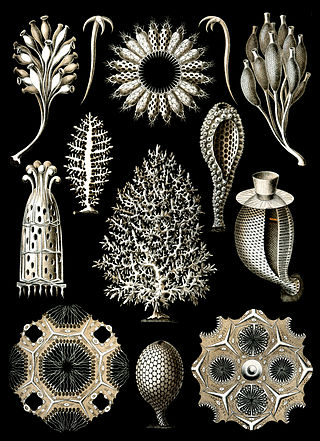
The calcareoussponges are members of the animal phylum Porifera, the cellular sponges. They are characterized by spicules made of calcium carbonate, in the form of high-magnesium calcite or aragonite. While the spicules in most species are triradiate, some species may possess two- or four-pointed spicules. Unlike other sponges, calcareans lack microscleres, tiny spicules which reinforce the flesh. In addition, their spicules develop from the outside-in, mineralizing within a hollow organic sheath.

Scalidophora is a group of marine pseudocoelomate ecdysozoans that was proposed on morphological grounds to unite three phyla: the Kinorhyncha, the Priapulida and the Loricifera. The three phyla have four characters in common — chitinous cuticle that is moulted, rings of scalids on the introvert, flosculi, and two rings of introvert retracts. The introvert and abdomen are separated by a distinct neck region in all groups, but in adult macroscopic priapulids it becomes rudimentary in Priapulus and is completely absent in Halicryptus. However, the monophyly of the Scalidophora was not supported by two molecular studies, where the position of the Loricifera was uncertain or as sister to the Panarthropoda. Both studies supported a reduced Scalidophora comprising the Kinorhyncha and Priapulida as sister phyla. Their closest relatives are the Panarthropoda, Nematoda and Nematomorpha.
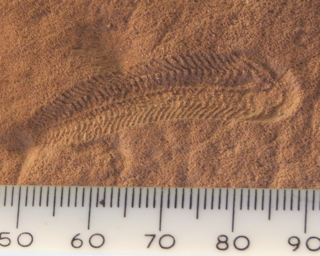
Spriggina is a genus of early animals whose relationship to living animals is unclear. Fossils of Spriggina are known from the late Ediacaran period in what is now South Australia. Spriggina floundersi is the official fossil emblem of South Australia; it has been found nowhere else.

Pambdelurion is an extinct genus of panarthropod from the Cambrian aged Sirius Passet site in northern Greenland. Like the morphologically similar Kerygmachela from the same locality, Pambdelurion is thought to be closely related to arthropods, combining characteristics of "lobopodians" with those of primitive arthropods.

Deuterostomes are bilaterian animals of the superphylum Deuterostomia, typically characterized by their anus forming before the mouth during embryonic development. Deuterostomia is further divided into four phyla: Chordata, Echinodermata, Hemichordata, and the extinct Vetulicolia known from Cambrian fossils. The extinct clade Cambroernida is thought to be a member of Deuterostomia.

Chuandianella ovata is an extinct bivalved arthropod that lived during Cambrian Stage 3 of the Early Cambrian. It is the only species classified under the genus Chuandianella. Its fossils were recovered from the Chengjiang Biota in Yunnan, China.
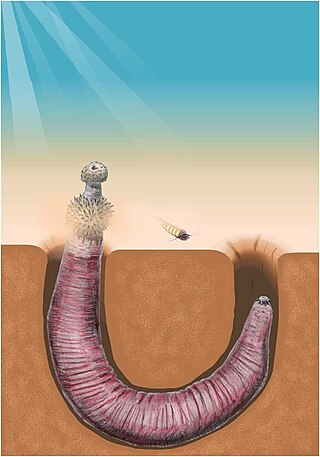
Archaeopriapulida is a group of priapulid worms known from Cambrian lagerstätte. The group is closely related to, and very similar to, the modern Priapulids. It is unclear whether it is mono- or polyphyletic. Despite a remarkable morphological similarity to their modern cousins, they fall outside of the priapulid crown group, which is not unambiguously represented in the fossil record until the Carboniferous. In addition to well-preserved body fossils, remains of several archaeopriapulid taxa are known to have been preserved primarily as organic microfossils, such as isolated scalids and pharyngeal teeth. They are probably closely related or paraphyletic to the palaeoscolecids; the relationship between these basal worms is somewhat unresolved.
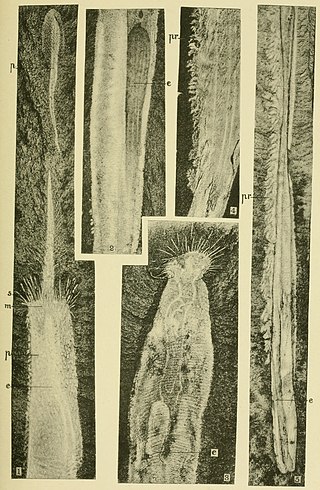
Louisella is a genus of worm known from the Middle Cambrian Burgess Shale. It was originally described by Charles Walcott in 1911 as a holothurian echinoderm, and represents a senior synonym of Miskoia, which was originally described as an annelid. 48 specimens of Louisella are known from the Greater Phyllopod bed, where they comprise < 0.1% of the community. It has been stated to have palaeoscolecid-like sclerites, though this is not in fact the case.

Salterella is an enigmatic Cambrian genus with a small, conical, calcareous shell that appears to be septate, but is rather filled with stratified laminar deposits. The shell contains grains of sediment, which are obtained selectively by a manner also observed in foramanifera. The genus was established by Elkanah Billings in 1861, and was named after the English palaeontologist John William Salter.
Vologdinella is a poorly known genus of extinct animals of uncertain classification with small cylindrical shells. The animals are known from Middle Cambrian fossils from a Paleozoic limestone in the Chingiz Mountains of Kazakhstan. The genus was established by Russian paleontologist Zakhar Grigoryevich Balashov in 1962 for a single species, Vologdinella antiqua, which was originally described and illustrated as Orthoceras? antiquus by Aleksandr Grigoryevich Vologdin in 1931.

Tactopoda or Arthropodoidea is a proposed clade of ecdysozoan animals that includes the phyla Tardigrada and Euarthropoda, supported by various morphological observations. The cladogram below shows the relationships implied by this hypothesis.
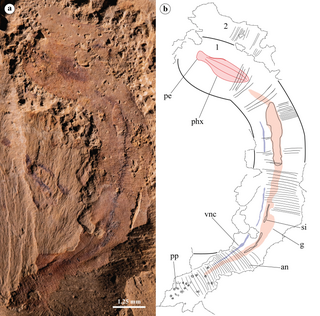
Acosmia is an extinct genus of marine worm from the Cambrian aged Chengjiang biota of Yunnan, China. It is represented by a single rare species, Acosmia maotiania, that reached 45 mm in length and 9 mm in width. It was likely a burrowing animal that fed by deposit feeding. While originally suggested to be a priapulid, a 2020 study proposed to be a stem-group ecdysozoan, due to lacking the radial pharygneal armature that characterises modern ecdysozoans, including priapulids.

Agmata is a proposed extinct phylum of small animals with a calcareous conical shell. They were originally thought to be cephalopods or annelid worms. The living animals filled up to five-sixths of their shell with laminae, angled layers composed of grains of quartz or calcium carbonate detritus from the environment cemented together, with larger grains near the shell wall and smaller grains near the center. A very fine tube ran through the center of the shell. The grains may be of quartz or calcium carbonate, but are of specific shapes and materials that are rare in the surrounding rock. Though the body of the living animal is not preserved, it had to be able to find, choose, and retrieve rare grains from its environment to build the laminae.

Saccorhytus is an extinct genus of animal possibly belonging to the superphylum Ecdysozoa, and it is represented by a single species, Saccorhytus coronarius. The organism lived approximately 540 million years ago in the beginning of the Cambrian period. Initially proposed as a deuterostome, which would have made it the oldest known species of this superphylum, it has since been determined to belong to a protostome group called the ecdysozoans.

Saccorhytida is an extinct phylum of Cambrian possibly belonging to the superphylum Ecdysozoa. It contains three monotypic genera: its namesake Saccorhytus, the dubious Clypecella and Beretella. All three genera are found in the early Cambrian of China.

Priapulus caudatus known as the cactus worm, is a marine invertebrate belonging to the phylum Priapulida. It is a cylindrical, unsegmented worm which burrows in soft sediment on the seabed. It has a circumpolar distribution.

















